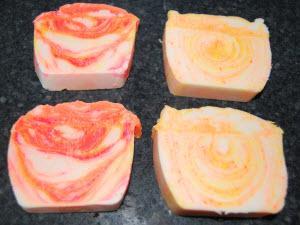 Color Dispersion in Soap
Color Dispersion in Soap
This picture shows the same exact recipe using two different methods of color dispersion in soap. Once the soap was poured, we noticed that some of the colorant was still on the sides of the bowls instead of actually incorporated into the soap (as shown in the soap on the right). In addition, we noticed concentrated pockets of colorant in this cut soap. Mainly, it is the difference between hand stirring the colorants in verses stick blending the colorants in, and failure to scrape the sides of the bowls to incorporate all of the coloring. Regardless of the method that you choose, there are distinct advantages and disadvantages. The key to knowing which method works best for you is knowing your soap recipe and the time that it allows you.
Color Dispersion in cold process soap making can be a tricky aspect. After you figure out your color scheme for your recipe and the technique as to how you are adding your color, it then comes down to the actual challenge.
Really there are three options to color dispersion in your soap. They are hand stirring the colorant into the batter with a spoon, stick blending the colorant in, or the combination of both. The correct decision relies on a few factors though. These factors are: your recipe, time, and the number of colorants you want to add.
Hand Stirring
The best advantage of hand stirring colorants into soap is that it does not speed up trace. This allows you the perfect fluid soap batter for accomplishing a multi color swirl in your soap. But, hand stirring the colorant into your soap batter is slightly more time consuming because you really have to stir for some time to get the colorant dispersed. So, this is where knowing your recipe and window of time, especially if you are using multiple colorants, comes into play.
You will also have to be ready to move. When hand stirring, you have to stir, and stir quickly to get the full color dispersion of the soap colorant. And, do not forget to have your spatula ready to clean the sides and rotate the soap from the bottom of the bowl to make sure all of the colorant is evenly dispersed.
However, not all colorants can be hand stirred. Some of the colorants do not disperse as well as others with this method. The examples of these types of colorants would be titanium dioxide and the ultramarines. Colorants like these often need to be stick blended in order to get the full color dispersion among all of the soap.
Stick Blending
Stick blending your colorants in soap batter is ideal for true color dispersion. But, with stick blending time is a major factor. Stick blending will speed up trace (or the saponification process) in your soap. If too much time elapses while stick blending your colorants into the batter; certain swirling techniques cannot be accomplished. This is because the soap batter will be too thick, especially if you are using more than two colors in your soap recipe.
Besides speeding up trace, there is another factor to consider. When using multiple soap colorants and stick blending you will have to quickly clean your stick blender in between colors. But, you do have a few options when it comes to this. Some soapers keep a small bowl of water by their coloring station to quickly clean their stick blender in between colors. And, some just stick blend their colors in the correct order, but gently tap the stick blender to remove as much colored batter as possible before moving on to the next color. For example if you are coloring your soap green and yellow; you would start by stick blending the yellow first. This is because the yellow color is the lightest, and then move to the green.
The Combo
For the situations where you want to use ultramarines which almost require a stick blend to get the best color dispersion, but you still want several other colors in your soap; you can combo the blend. You would start by stick blending the colorants that need it, and then move on to the hand stirred colorants. If the stick blended colorants become too thick, simply stir them by hand and the soap batter will thin out slightly (or enough to pour). Just remember, you must move quickly.
What this really all comes down to is testing. Through making various batches of soap, you will be able to find exactly which method of color dispersion is best for you and your soaping recipe. There really is no right or wrong answer as to which method to use. Each soap recipe will vary.
Natures Garden offers FUN Soap colorants for soap making. We even carry multiple neon colors to really make your soap “come alive”.

